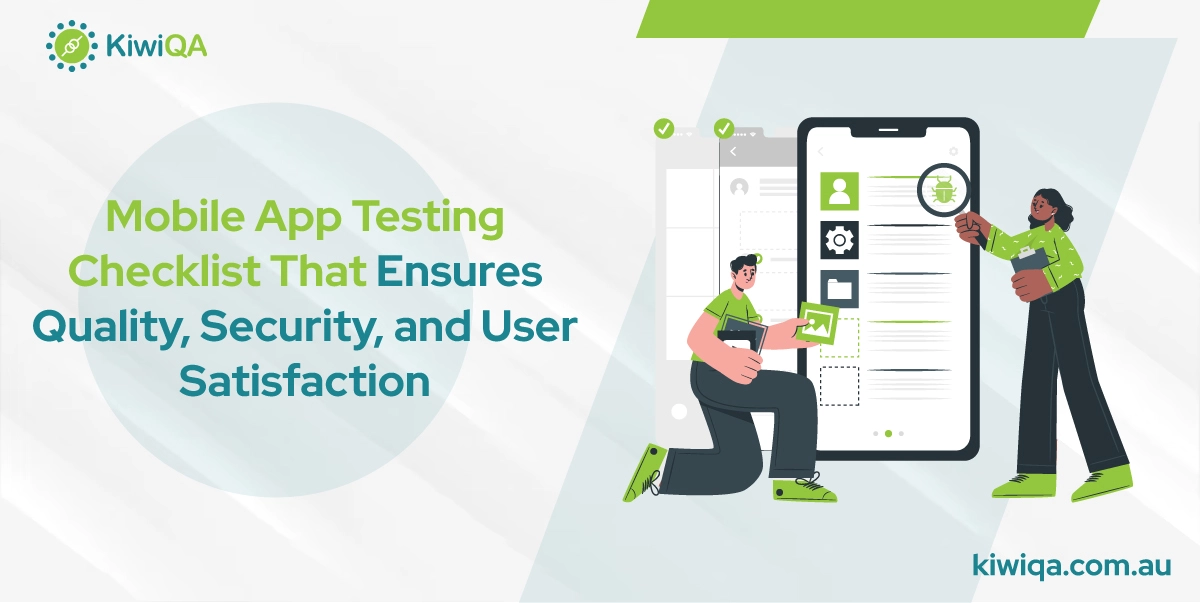Mobile App Testing Checklist That Ensures Quality, Security, and User Satisfaction

Mobile applications have taken the entire world. For every developer & QA, it’s a responsibility to release every app in the best possible state. Every bug that you ignore risks dissatisfying a user & causing users to uninstall or delete the app. 50% of applications are abandoned within a minimum of 30 days of their release. If you don’t want to get into this situation, then you need to have a proven mobile app performance testing checklist at hand.
In 2025, users are expecting an application with flawless performance across every device & OS. Skipping testing practices is risky. Reports said that an app lost 77% of regular active users within 3 days of installation. Understanding the importance of the user satisfaction rate in app retention emphasizes the requirement of testing.
By collaborating with expert mobile app testing services, businesses can maintain quality, security, and user satisfaction. Leverage expertise if you want to stand out in the market. This blog covers the necessary methods to get your app launch-ready. From functional assessments to security evaluation, we’ll talk about the brief checklist mobile app testing in this blog.
Mobile app testing is non-negotiable, since current users have zero tolerance for poor performance. With millions of apps out there, users will quickly abandon or uninstall the application if it fails to meet the high standards. It makes comprehensive testing a crucial investment for brand reputation and business growth.
Nowadays, app users are sophisticated & demanding, so they are expecting an application that must have a seamless user experience, flawless performance, and cross-platform compatibility. An ideal application should offer instant load time and intuitive UX. Apps with positive reviews & zero crash history emphasize their quality. The limitless user expectations make mobile application testing a non-negotiable task.
App stores have guidelines & standards that apps require to meet. Performance testing ensures compliance with the standards in terms of responsiveness and loading times. Mobile applications often handle sensitive information, like financial & personal data. Testing the security of your application will help to avoid identifying app errors.
Furthermore, the app’s credibility can be improved when data security is verified. Don’t let your application be ranked in the list of uninstalled apps due to data breaches, insecure APIs & privacy concerns. To maintain success in the competitive marketplace, make sure the app meets all the compliance requirements, like GDPR, HIPAA, etc.
Mobile device specifications can vary widely in terms of screen size and hardware/software. By approaching compatibility testing, businesses can ensure a stable user experience on every device and OS. When you release an app without testing, it might work on one device, but crash on others. Performance testing also ensures that the app delivers a consistent & smooth user experience across the whole range of devices.
Testing a mobile application’s functionality is necessary to validate user satisfaction. One of the most important phases in the mobile app performance testing checklist is functionality testing. It must be included in any quality control plan. By taking care of every possible problem, you can ensure that the app is ready to be released to the users.
A seamless experience and an easy-to-use interface are crucial. Make checking layout consistency, animations, a top priority on your mobile app testing checklist. Additionally, make sure that consumers can easily navigate and that designs adjust effectively to different screen sizes.
After the initial impression, an app’s usability has a direct impact on user happiness and can make or break its retention. A thorough Mobile App UI/UX checklist for mobile app testing guarantees that the application is aesthetically pleasing, user-friendly, and offers a satisfying experience.
Various devices & OS versions can result in unpredictable behavior. Your mobile app testing checklist must include this check across devices. It is responsible for measuring screen resolution & platforms such as Android & iOS. Verify that the app operates seamlessly on older and new versions by running this test. Furthermore, carrying out this testing limits the chances of user frustration & uninstallation due to platform-related errors.
Currently, crashes are the reason behind 71% of uninstalls. The fact that 41% of these problems are discovered by the users themselves is what makes this situation so serious. Mobile app accessibility testing checklist is, therefore, one of the fundamental QA procedures. Performance testing helps find issues like crashes, battery drains, and slowdowns that might not show up until your program is live. This type of testing guarantees that your application functions well under pressure and maintains its stability as user demand increases. Consequently, it has a direct effect on important mobile app KPIs, including user pleasure, crash rate, and retention.
For safeguarding users’ data by mitigating access to illegal activities, a mobile app security testing checklist is essential. Frequent security testing will guarantee that your software is safe for users and assist in detecting any possible risks. Data is counted among the precious resources for a business. The primary concern of every user while downloading an app is data security.
Ensure the user’s information is safeguarded from unwanted access by doing all necessary tests. Determine potential situations that could lead to a data breach and do thorough testing to strengthen the application against them. Remember that no mobile app testing checklist can compromise on security guarantees.
Testing the accuracy and responsiveness of apps that depend on location services is crucial. To make sure the program functions properly across many languages, date/time formats, and currencies, localization is also crucial. Verify that users in various locations can utilize the app without any problems and that it is customized to suit their local tastes. Multiple languages and regional customs must be accommodated by a worldwide app. Verify that translations appear accurately when performing the Android mobile app testing checklist.
Designing a mobile app with usability in mind is essential. If an application is tough to access, the chances of abandonment by users are high. Your app’s usability determines its success. The ease of user engagement can be measured under the Android mobile app testing checklist. Investigate user needs and determine whether the app can meet them through usability testing.
There are so many complaints from users regarding how an application isn’t working after the update. Through updated testing, the app can be qualified as it functions well & works seamlessly. Mobile app updates can occur in 2 ways: manual & automatic updates. Make sure the app works effectively after the programmed update. Installation/uninstallation testing verifies that the app is installed/uninstalled properly. It assists in determining whether the app updates get applied seamlessly.
The user needs to be logged into our app in order to receive a push notification. The app should launch and direct the user to the content linked to the push notification when they tap on it. The mobile app usability testing checklist must outline multiple test cases for verifying, such as getting a notification while the app is running in the foreground/background. Check whether the notifications come when the app isn’t running. Check how the app handles push notifications when users are accessing multiple devices at the same time.
A comprehensive mobile app testing covers crash & error handling testing. Under this testing process, the app’s behavior is tested. Verify the data integrity & resolution by simulating the memory or storage conditions. Observe app stability and verify the app manages resource warnings. You must test the behavior of the app when it runs in the background for a long time.
Test app behavior during interruptions like notifications, incoming calls, and alarm events. Simulate network loss & reconnection during crucial operations. The mobile application testing solutions also verify whether the error notifications are visible or not. Simulate multiple API response errors & verify the app handles the errors gracefully.
Functional Testing: Based on a study, the failure rate of the app ranges from 50 to 80%. The functional testing is responsible for verifying that the software is functioning well as per the expectations. It helps to limit the failure rate to a larger extent & ensure every function operates correctly. The selection of the right tool is one of the necessary decisions to avoid functional limitations.
1. Appium- This popular free tool is responsible for automating the native, web, and hybrid apps on iOS, Android & Windows platforms. The tool encourages cross-platform app testing, enabling users to write tests against various platforms utilizing a similar API. It allows code reuse between Android, iOS & Windows test suites. The tool is compatible with all systems and covers a vast selection of coding.
2. Espresso- This Android-specific free tool was created by Google and is fully integrated into the Android SDK. This tool is designed for executing the functional tests, validating the app behavior from the users’ perspective. It allows execution of functional testing by offering APIs to search UI elements, perform actions & verify their state.
3. XCUITest- This is Apple’s native UI testing framework, integrated within Xcode. It is used for automating the functionalities and UI testing for iOS apps. It’s a framework for writing & executing tests. It is a testing method used when the QA team has code accessibility. Integration with Xcode enables testing execution directly from Xcode. It allows quick test execution, easy setup, minimal testing, and native support.
4. Performance testing: An effective performance test can safeguard your app from 90% of performance-related errors. Mostly the app crashes during black Friday sales or festive sales. In performance testing, you are stress testing your application to see where it breaks. The response time is monitored under peak traffic, and then the QA team will deliver the report.
5. Firebase Performance Monitoring- This powerful tool offers a solution to get insight into your app performance in real-time. It focuses on user-facing metrics and offers robust monitoring capabilities. When combined with the popular performance testing tools, it delivers a more effective approach.
6. Android Profiler- This tool is popular for testing Android applications. It allows developers to identify & address performance errors within the apps. Executing the performance testing checklist helps you analyze memory usage, CPU usage, network activity, UI rendering, etc.
7. Security: With 3.7 billion active smartphone users worldwide, securing mobile applications is not an optional task. It is necessary to secure your application from vulnerabilities such as data leaks and malware threats. You can find lots of open source and enterprise-level tools in the market.
8. MobSF- This is a renowned security tool that performs static, dynamic & API analysis for iOS, Android & Windows mobile apps. It supports both source code and binaries. This open-source, locally hosted tool supports APK and zipped source code. It allows quick setup for the app testing environment and support while detecting errors in the early stage.
9. OWASP ZAP- This is a free tool used for the execution of a web app security checklist. It helps the QA team to find XSS, broken authentication, and SQL injection through automated scans. This is an ideal tool for the vast user base, from newbie to expert QA professionals.
10. Crash Reporting: Effective reporting tools help to automate the steps of the crash reporting checklist by offering detailed, real-time data. It is necessary to maintain the app stability and reduce errors.
11. Firebase Crashlytics- A portable, real-time crash reporter, Firebase Crashlytics assists you in monitoring, prioritizing, and resolving stability problems that degrade the quality of your application.
12. Sentry- Sentry is a performance-tracking and error-tracking solution that offers real-time warnings and comprehensive, actionable insights to assist you in carrying out a crash reporting process.
13. Usability/Analytics: You can learn more about user behavior, preferences, and pain spots by using the usability testing tools listed below. In the end, these technologies result in increased user engagement and happiness.
14. Mixpanel- Mixpanel is a sophisticated product analytics tool that uses event-based tracking to help you understand how consumers engage with your product.
15. UXCam- It assists you in locating, evaluating, and fixing usability problems that conventional analytics could overlook by recording and displaying actual user interactions.
16. Hotjar- Using a variety of methods, Hotjar is an analytics and feedback platform that assists you in comprehending how users behave on your website.
For an e-commerce application, you must prioritize tests that cover the crucial user journeys. Focus on the high-traffic features and high-risk areas that directly impact customer satisfaction & revenue. App failure in these areas can have big consequences such as lost sales, data breaches & damaged brand reputation. The QA team always prioritizes the sections like payment gateway, security, performance, and transactional flow, etc.
To verify the quality and security of a social media app, prioritize testing and validate the real-time performance and scalability of your application. Testers should focus on areas like user login, uploading, search functionality, etc. Focusing on such areas ensures a seamless, stable & highly interactive user experience. Test the crucial areas carefully & frequently, to maintain the high volume traffic and avoid network instability.
For verifying the quality of an enterprise application, the QA mobile application testing services team should prioritize the sections like security, authentication, and device policy. The testing strategy must be strategically aligned with the company’s goals. A single glitch can cause financial, security, and operational risks.
Regression testing must be automated in order to preserve software quality in hectic CI/CD settings. By using the appropriate tactics and resources, organizations can make sure their apps stay dependable and stable even with regular upgrades. Maintaining software quality requires regression testing, especially in dynamic, fast-paced CI/CD settings.
For mobile applications in particular, ensuring thorough test coverage in an Agile and CD environment necessitates a calculated strategy that makes use of both emulators and actual devices. In the early phases of development, emulators are perfect for providing rapid feedback since they let engineers test code modifications and unit functionalities quickly without the inconvenience of physical hardware. To make sure the program works well in end users’ hands, give real device testing top priority for final validation before release.
Canary and staggered rollouts are essential tactics in agile and continuous deployment that test new software versions in production with a constrained scope, enabling real-world feedback while lowering risk. By confirming that modifications operate as intended for actual users prior to a broader release, these methods complement thorough test coverage.
For Agile and Continuous Deployment to be effective, test coverage and user feedback must be continuously reviewed. This procedure guarantees that the provided software genuinely satisfies user expectations and that testing efforts stay in line with changing requirements.
Mobile app performance testing is a proactive strategy that needs an effective approach. By leveraging the ideal tools & methodologies, developers can ensure the app not only matches technical benchmarks but delivers an outstanding user experience. By following the comprehensive checklist for mobile app testing we mentioned above, you can guarantee the app quality, performance, and user experience. To get an idea about more testing practices, read some other blogs on app testing and best mobile app testing practices.
Subscribe to our newsletter for some hand-picked insights and trends! Join our community and be the first to know about what's exciting in software testing.
Welcome to the testing tales that explore the depths of software quality assurance. Find valuable insights, industry trends, and best practices for professionals and enthusiasts.

Fill out and submit the form below, we will get back to you with a plan.
 CRN:
22318-Q15-001
CRN:
22318-Q15-001 CRN:22318-ISN-001
CRN:22318-ISN-001 CRN:22318-IST-001
CRN:22318-IST-001